Ivan Sutherland: The Man Behind VR

Ivan Sutherland was born in 1946 in Oakland, California. He is an American computer scientist, best known for his pioneering work in the field of computer graphics and virtual reality.
In the late 1960s, he developed Sketchpad, one of the earliest computer graphics programs, which allowed users to create and manipulate simple shapes on a screen.
However, it was Sutherland’s work in the early 1970s that truly revolutionized the world of computing. In 1972, he created a program called “Swordfight,” which allowed two players to engage in a virtual duel using simple shapes and colors on a computer screen. This was the first ever VR experience, predating the creation of Oculus Rift and HTC Vive by decades.
Sutherland’s work in VR did not stop there. In 1973, he developed “The Ultimate Display,” a system that used stereoscopic displays to create a three-dimensional image on a single screen. This was another groundbreaking innovation that paved the way for future VR technologies.
Early Years of VR: The Challenges and Triumphs
The early years of VR were marked by several challenges and triumphs. One of the main challenges was the lack of technology to create realistic 3D images on a screen.
This led Sutherland to experiment with different techniques, including stereoscopic displays and computer-generated imagery.
Another challenge was the difficulty in creating interactive experiences that could respond to user inputs in real-time. Sutherland’s “Swordfight” program was one of the first attempts at this, but it was still a far cry from the immersive VR experiences we have today.
Despite these challenges, there were also several triumphs during the early years of VR. One of the most notable was Sutherland’s work on “The Ultimate Display,” which demonstrated the potential for stereoscopic displays to create a three-dimensional image on a single screen. This breakthrough laid the groundwork for future VR technologies, such as head-mounted displays and haptic feedback systems.
Another triumph was Sutherland’s involvement in the development of the first ever VR headset, known as “The Cave.” In 1968, he worked with a team of engineers to create a prototype of this device, which used mirrors and a projector to create a three-dimensional image that could be viewed from any angle. Although the technology was limited, it marked a significant step forward in VR research and development.
Real-Life Applications of VR: From Gaming to Medicine
Today, VR technology has many real-life applications across various industries. One of the most popular uses is in gaming, where VR headsets and controllers allow users to immerse themselves in a virtual world and interact with characters and objects in ways that were previously impossible.
However, VR also has applications in other fields, such as medicine and education. For example, surgeons can use VR simulations to practice complex procedures and gain valuable experience before performing them on actual patients.
Similarly, students can use VR simulations to learn about history, science, and other subjects in a more engaging and interactive way.
The Future of VR: Where We’re Heading Next
As VR technology continues to evolve, we can expect to see even more innovative applications and uses for this revolutionary technology. Some of the areas where VR is likely to have a significant impact include healthcare, education, entertainment, and retail.
For example, in healthcare, VR can be used to create simulations that allow doctors and nurses to practice complex procedures and gain valuable experience before performing them on actual patients. This can lead to better patient outcomes and reduced risks of complications.
In education, VR can be used to create immersive learning experiences that engage students and help them retain information more effectively. For example, a student could use a VR headset to explore ancient Rome or the human body in a way that was previously impossible.
In entertainment, VR can be used to create highly immersive gaming experiences that transport players into new worlds and allow them to interact with characters and objects in ways that were previously impossible. This has already led to the creation of several popular VR games, such as “Beat Saber” and “Alyx.”
In retail, VR can be used to create virtual showrooms that allow customers to browse products and make purchases from the comfort of their own homes. This could lead to increased convenience for consumers and reduced costs for retailers.
Conclusion: The Legacy of Ivan Sutherland
Ivan Sutherland’s pioneering work in VR has had a profound impact on the world of technology, and his legacy continues to inspire innovators today. From his early experiments with stereoscopic displays to his involvement in the development of the first ever VR headset, Sutherland’s contributions have laid the groundwork for the incredible technological advancements we see today.
As VR technology continues to evolve and new applications emerge, it is likely that we will see even more innovative uses for this revolutionary technology. From healthcare to education to entertainment and beyond, the potential for VR to transform our lives is virtually limitless.
